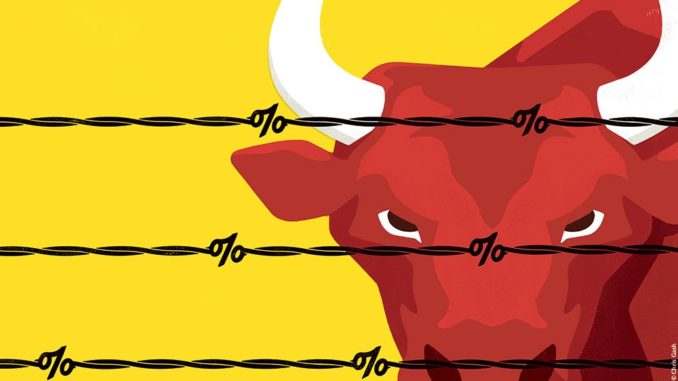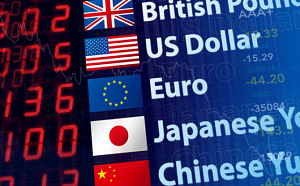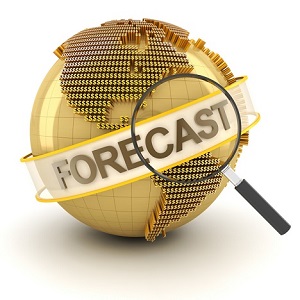
The S&P 500 And U.S. Economy Face Seismic Shifts From Joe Biden And The Fed By Investors Business Daily
With massive fiscal outlays set to supercharge the U.S. economy’s vaccine-enabled recovery, the Dow Jones and S&P 500 are enjoying an old-economy moment. Oil, steel, machinery and banking stocks caught fire as the $1.9-trillion American Rescue Plan moved toward passage this month.
Wall Street firms now predict the U.S. economy will surge 8% this year. The last time GDP growth cracked 5% came as Apple (AAPL) introduced the original Mac more than a quarter-century ago.
Now, as President Joe Biden gets ready to tee up another massive spending package focused on infrastructure, Wall Street is weighing what unleashed fiscal policy might mean for interest rates, tax rates and stock prices.
The implications are magnified by the Federal Reserve’s recent about-face on inflation, from standing on guard against it to trying to stoke it. The combination of easy fiscal and monetary policy may lift the Dow Jones and S&P 500 in the near term. Yet some on Wall Street think it could mean lower returns in the future.
The seismic shifts in fiscal and monetary policy are drawing comparisons to another old-economy moment: the latter half of the 1960s. That era was marked by strong economic growth. But it also brought rising inflation — and a long-term stock market top.
S&P 500 Hits Highs While Techs Slip
The Dow Jones and S&P 500 index rallied to new highs this month, though they have pulled back modestly in recent days. The Nasdaq remains 9% off its Feb. 16 peak, selling off this week What ails big techs that dominate the Nasdaq, like Apple stock, Amazon.com (AMZN) and highly valued growth names such as Tesla (TSLA)?
Tech giants are no longer are the only game in town given the bullish outlook for cyclical and value stocks. Meanwhile, the surge in Treasury yields has led stock market strategists to rethink growth stock valuations — and much more.
Fiscal, Fed Policy A Paradigm Shift For S&P 500, Economy
It’s now clear that Wall Street underestimated the significance of Jan. 5 — the day Georgia handed control of the Senate to Democrats and breathed life into the Biden agenda.
Jason Draho, who directs asset allocation for UBS Financial Services in the Americas, now sees “a legitimate possibility” that the U.S. economy may break out of the low growth, low inflation, low interest rate paradigm that became entrenched after the financial crisis. “What seemed improbable six months ago is becoming increasingly plausible and investors need to be prepared,” he wrote in a March 12 post.
For now, market pricing reflects expectations that a bounce in inflation much above 2% will prove temporary, he says. But “these views will likely change if the Fed and the Biden administration don’t take their feet off the gas pedal.”
Joe Biden’s $1.9 Trillion Stimulus: Step One Of Two
If not for Jan. 5, the latest round of fiscal stimulus might have been $1.25 trillion smaller — like the $600 billion package pitched by moderate GOP senators.
The Democrats’ bill went well beyond $1,400 stimulus checks, emergency jobless aid and funds for Covid vaccines and testing. Washington also will send $580 billion to state and local governments. That “is significantly higher than the estimated $85 billion net budget shortfall facing state and local governments,” wrote Moody’s Analytics economist Bernard Yaros.
More than just a bridge to recovery, the White House pitched Biden’s plan as a fix for longstanding economic ills and “stark, intergenerational inequities.” The law expands the earned income tax credit to childless workers. It gives more generous subsidies to buy health coverage via state insurance exchanges or HealthCare.gov. And it increases the child tax credit from $2,000 to $3,600 per younger child and $3,000 for those 6 and up. Previously, the tax credit topped out at $1,400 for those who don’t earn enough to pay taxes.
The White House has touted research estimating its plan could cut child poverty in half. Such progress might prove fleeting if the bulk of the Biden stimulus lasts just one year, as the law provides.
That’s why these and a few other key provisions may be made permanent in part two of what Biden has said will be a “two-step plan of rescue and recovery.”
“Permanent” is the key word. To avert a Senate filibuster, Democrats will once again play by budget reconciliation rules that prohibit deficit spending outside of the 10-year budget window.
Biden Tax Hikes Coming
Extending stimulus tax provisions for the next decade would cost roughly $2 trillion. That’s a good ballpark estimate of the tax hikes or spending offsets that Biden would need to make his poverty-reduction program and bigger health subsidies permanent. Universal pre-K, free community college and a national paid leave program also may be in the next bill, the New York Times reported.
“Where we’re making permanent investments, recurring investments, we will pay for them by making sure everyone pays their fair share” in taxes, Biden said Jan. 14.
Biden also promised “historic investments in infrastructure, manufacturing, innovation, research and development, and clean energy.” These more tangible investments, however, would involve a one-time appropriation that could be financed with deficits.
The Biden campaign’s plan to spend $2 trillion on green-tinted infrastructure over four years will likely serve as a starting point. The whole package could add up to $4 trillion, Goldman Sachs estimates.
Under reconciliation limits, the next package can’t take effect before the next fiscal year starts in October. But Democrats will aim to move quickly to nail down the details — and the votes — before the pandemic loosens its grip on the U.S. economy.
All The Money Sloshing Around U.S. Economy
Even before Biden’s $1.9 trillion stimulus passed, the U.S. economy looked primed for a robust recovery. The Federal Reserve’s $3.4 trillion in asset purchases and the roughly $4.5 trillion in Covid recovery funds Congress approved in 2020 largely succeeded in fortifying the U.S. economy against a sustained hit.
Household wealth surged by $12 trillion in 2020, making Q1’s sudden drop of $7 trillion, or 6%, look like a mere pothole. During the financial crisis, wealth plunged 15%. It took five years to recover.
Economists expect record job growth in 2021. Yet the aggregate wages and salaries paid to American workers already hit a new record in January, surpassing February 2020’s pre-Covid high. By contrast, it took three years from the start of the 2007-2009 recession for wages and salaries to eclipse their pre-recession level.
With fewer ways to spend money, Americans have socked away a bigger slice of income over the past year. Some of that $1.6 trillion in excess savings could help fuel a consumption boom.
All that money sloshing around, plus the just-passed $1.9 trillion stimulus and another massive spending package on the way, raises an obvious question: Will the lessons that Federal Reserve policymakers learned in the last cycle still apply in this one?
Federal Reserve Kept Policy Too Tight
For most of the past decade, the Federal Reserve remained on inflation high alert. The Fed began tapering asset purchases at the end of 2013, with the jobless rate still near 7%. The first rate hike came in December 2015, with unemployment at 5%.
At the time, Fed Chair Janet Yellen said that the U.S. economy was “not quite there, but reasonably close” to achieving maximum employment. The upshot: inflation could begin to heat up as the job market tightened further.
As it turned out, the jobless rate kept falling. It averaged 3.6% in the 12 months before Covid hit. Yet inflation kept undershooting the Fed’s 2% target.
That prompted a mission rethink. To keep the U.S. economy from sinking into a low-inflation, low-growth dynamic, the Fed adopted a goal to boost inflation above 2% for a time.
That upending of monetary policy was an implicit recognition that the Fed had long held policy too tight, at the cost of slower wage growth and less opportunity. Policymakers vowed not to make the same mistake again.
S&P 500 Thrived During Federal Reserve’s Low-Rate Regime
Wall Street cheered as the Fed formalized its commitment in August to keep its key interest rate at rock bottom until inflation was firmly above 2%. Yet even under the Fed’s overly tight policy, the S&P 500 fared just fine.
Amid scarce growth, investors had piled into fast-growing tech stocks like Facebook (FB), Amazon, Netflix (NFLX) and Google parent Alphabet (GOOGL), along with highfliers such as Shopify (SHOP) and Tesla stock. And the historically low 10-year Treasury yield used by Wall Street to value future cash flows helped push big growth-stock valuations to rare heights.
Now growth is no longer scarce and the 10-year Treasury yield is recovering much faster than most economists expected. And suddenly, investors are more enamored with energy, materials, machinery and financial stocks in the Dow Jones and S&P 500.
Fiscal, Federal Reserve Policies Are Potent Mix
By itself, the Fed’s new pro-worker bent might not revive inflation. But the combination of full-throttle monetary and fiscal policy could change the game. Nothing remotely like it has been tried since the mid-1960s.
Consider how much Fed policy has changed since 2018. President Trump promised that his tax cuts would provide “rocket fuel” for the U.S. economy. But the Fed almost immediately diluted their punch by accelerating rate hikes. After the stock market nose-dived, the Fed backpedaled furiously, cutting its key rate three times in 2019.
Yet by then, the growth impetus from tax stimulus had waned and factories had slowed amid recurring flare-ups of the China trade war.
To some extent, the Trump tax cuts might even be considered disinflationary. Corporate income tax cuts gave businesses flexibility to hold the line on prices and still grow profits. Some utilities passed along price cuts, sharing their windfall with consumers.
Biden’s stimulus and infrastructure plans, on the other hand, seem designed to have the maximum inflationary thrust. Instead of lower corporate taxes, he’s expected to partially reverse Trump’s corporate tax cut. While raising taxes on the highest earners, Biden aims to redistribute wealth to those with the highest propensity to spend. Low- and moderate-income households (those earning up to $91,000) got just 17% of the Trump tax cuts, but they’ll get 67% of Biden stimulus tax cuts, the Tax Policy Center finds.
Biden’s tax and spending package could be good news for certain sectors, such as Dow Jones giant Caterpillar (CAT) and other infrastructure stocks. But higher corporate and capital gains tax rates would be a negative for the S&P 500 and especially growth stocks.
Mid-1960s Offers Parallel For Fiscal, Fed Stance
Biden hailed the new law’s focus on growing the economy “from the bottom up and the middle out,” after decades of supply-side, or “trickle down” tax policies. It “changes the paradigm” for the first time since President Johnson’s Great Society programs, he said.
But the last time free-spending, inflation-permissive “regime shifts for fiscal and monetary policymakers” coincided, wrote Deutsche Bank economists David Folkerts-Landau and Peter Hooper, “such shifts touched off a sustained surge in inflation in the U.S.,” beginning in 1966.
Growth in core prices, which exclude food and energy, jumped from well under 2% in 1965 to nearly 3.5% in 1966 and approached 5% by late 1968, Deutsche Bank noted. Inflation remained elevated into the early 1970s, even before an oil shock hit in 1973. The pickup was broad-based, but health care inflation played a key role, going from less than 3% to nearly 7% by early 1967.
The S&P 500 suffered through a bear market in 1966. Another 19-month bear market began in late 1968. The Dow Jones made a major top in January 1966. It would take the Dow Jones until 1982 to finally break through that ceiling for good.
Outlook For Inflation, Federal Reserve Policy
Almost everyone expects a notable pickup in inflation this year — including the Fed. Monetary policymakers expect the personal consumption expenditures (PCE) price index to rise 2.4% this year. That’s vs. 1.5% in the 12 months through January.
Fed Chair Jerome Powell said March 17 that the Fed will discount this year’s jump in prices as a transitory bounce from pandemic-induced weakness. What happens in 2022 will be key. Fed projections show inflation easing back to 2%. But if pressures don’t ease, the Fed will have to reassess its 2024 timetable for the cycle’s first rate hike.
It’s easy to see how Fed projections might understate next year’s inflation. Policymakers likely are not factoring in any impact from the Democrats’ next massive spending package.
Yet subdued health care prices may help keep inflation in check as pandemic supports end. A 2% hike in Medicare reimbursements is scheduled to lapse in April. A 3.75% increase in Medicare fees for physicians could end in January, Deutsche Bank said.
Democrats also are eyeing spending curbs to help pay for their infrastructure package. Letting Medicare negotiate prescription drug prices is high on the list of options.
Longer term, the inflation outlook may depend on whether a post-pandemic productivity boom offsets upward price pressure as globalization backslides.
10-Year Treasury Yield Surges On U.S. Economy Growth Outlook
This week, the 10-year Treasury yield has eased to 1.61%, after hitting 1.75% last week, the highest of the Covid era. Still, the 10-year yield is up 66 basis points since Jan. 5.
Financial market pricing now indicates an expectation that inflation will average 2.31% over the coming decade. That’s the difference between the 10-year Treasury yield and the -0.70% yield on 10-year Treasury Inflation-Protected Securities, or TIPS
“Negative real yields seem highly incongruous with the robust economic growth in train,” Moody’s Analytics chief economist Mark Zandi wrote. As real yields rebound, Zandi sees the 10-year Treasury yield reaching 2% by year end, 2.5% in 2022 and 3% by late 2023.
What Do Taxes, Interest Rates Mean For S&P 500?
As the new fiscal and monetary policy regime takes hold, investors will have a lot to process. If the era of too-little inflation and ultralow interest rates is drawing to an end, but earnings growth surges as the economy catches fire, what will that mean for the S&P 500? And how might tax hikes affect stock prices?
Despite rising rates and looming tax hikes, UBS equity strategist Keith Parker remains bullish. He thinks earnings will pack an even bigger punch.
Much of the S&P 500 earnings increase will come in real economy and reopening plays, rebounding from a difficult 2020 and turbocharged by stimulus spending.
On March 9, Parker hiked his year-end S&P 500 target to 4250, up 9% from Tuesday’s close, and set a 2022 target of 4500. Parker sees cumulative earnings per share for the S&P 500 companies surging 32% to $188 this year, followed by 16% growth to $218 in 2022.
The UBS economics team holds the out-of-consensus view that annual core PCE inflation won’t exceed the Fed’s 2% target until 2024. Chief U.S. economist Seth Carpenter expects the new stimulus checks to be largely saved. The next fiscal package might likewise have a “muted” bang for the buck, while adding just $600 billion to the federal deficit.
Even if those estimates are off the mark, Parker offers a useful framework for navigating “unprecedented cross-currents” ahead.
Key Factors To Watch
Corporate Taxes: Parker sees a potential 8% hit to S&P 500 earnings from corporate tax hikes. Biden has proposed hiking the corporate rate from 21% to 28%. He wants to double the tax rate on global intangible low-taxed income. He also backs a minimum 15% tax on book income, or GAAP income reported to shareholders. Some moves are aimed at Amazon and other giants that have paid little or no corporate tax in many years. UBS predicts a range of more moderate changes, including a 25% corporate tax rate, that add up to a smaller 3.6% EPS haircut for the S&P 500.
Interest Rates: Parker finds that a 50-basis-point rise in the 10-year Treasury yield compresses price-earnings multiples by six-tenths of a point. Based on the S&P 500’s current forward earnings multiple of about 21.5, that would equate to about a 3% decline in the S&P 500.
Capital Gains Taxes: Biden has proposed hiking the capital gains tax rate from 20% to 39.6% for high earners. Parker figures that could slice 1.5 points off the S&P 500 P/E multiple, potentially a 7% hit. However, UBS expects that not quite half the tax plan will become law.
Parker arrives at a 19.5 forward earnings multiple for the S&P 500. That also factors in some compression because the fiscal boost to earnings is bound to slacken. “The market doesn’t put a peak multiple on peak earnings,” he told IBD.
Strategists See S&P 500 Headed Higher, But …
“While the easy monetary/tight fiscal combination promoted a rise in asset prices rather than consumer prices ever since the end of the global financial crisis, today’s easy monetary/easy fiscal could promote consumer price inflation and asset price deflation,” BCA Research strategists Doug Peta and Matt Gertken wrote in a Feb. 24 report.
Yet most strategists expect the S&P 500 to head higher, and even BCA remains “constructive on risk assets” this year. The trick will be navigating likely air pockets.
Heading into the second quarter, Barry Knapp, managing partner at Ironsides Macroeconomics, sees a confluence of powerful forces lifting the S&P 500.
Macro tailwinds will be “at their maximum point of velocity in the second quarter,” Knapp said in a March 15 podcast. At the same time, “we are getting maximum liquidity injections” into the U.S. economy. In addition to $400 billion in stimulus checks, the Fed is buying $120 billion per month in Treasuries and mortgage securities. On top of that, Treasury is drawing down more than $1 trillion in cash balances to minimize near-term borrowing.
“With all of those things going for the markets, it’s hard to see a significant setback — until and unless we get deep in on the Biden tax hikes and the Fed starts talking about talking about tapering.”
Forex Intraday Technical Analysis Tradeplans and Long-Term Forecasts
Forecasts On Shanghai Hong Kong Japan Australia South Korea Singapore Taiwan India Indicies



